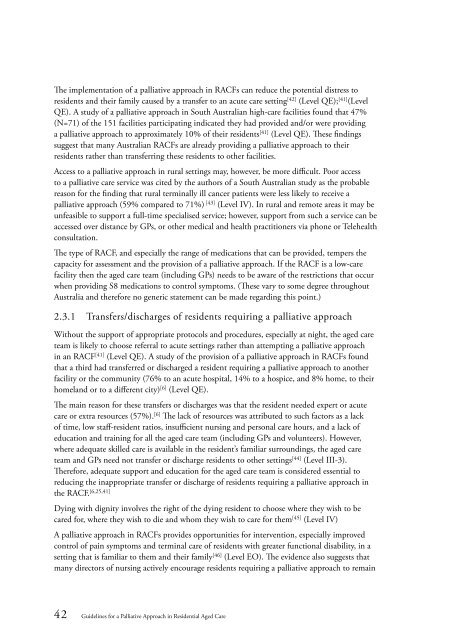Guidelines for a Palliative Approach in Residential Aged Care
Guidelines for a Palliative Approach in Residential Aged Care
Guidelines for a Palliative Approach in Residential Aged Care
Create successful ePaper yourself
Turn your PDF publications into a flip-book with our unique Google optimized e-Paper software.
The implementation of a palliative approach <strong>in</strong> RACFs can reduce the potential distress to<br />
residents and their family caused by a transfer to an acute care sett<strong>in</strong>g [42] (Level QE); [41] (Level<br />
QE). A study of a palliative approach <strong>in</strong> South Australian high-care facilities found that 47%<br />
(N=71) of the 151 facilities participat<strong>in</strong>g <strong>in</strong>dicated they had provided and/or were provid<strong>in</strong>g<br />
a palliative approach to approximately 10% of their residents [41] (Level QE). These f<strong>in</strong>d<strong>in</strong>gs<br />
suggest that many Australian RACFs are already provid<strong>in</strong>g a palliative approach to their<br />
residents rather than transferr<strong>in</strong>g these residents to other facilities.<br />
Access to a palliative approach <strong>in</strong> rural sett<strong>in</strong>gs may, however, be more difficult. Poor access<br />
to a palliative care service was cited by the authors of a South Australian study as the probable<br />
reason <strong>for</strong> the f<strong>in</strong>d<strong>in</strong>g that rural term<strong>in</strong>ally ill cancer patients were less likely to receive a<br />
palliative approach (59% compared to 71%) [43] (Level IV). In rural and remote areas it may be<br />
unfeasible to support a full-time specialised service; however, support from such a service can be<br />
accessed over distance by GPs, or other medical and health practitioners via phone or Telehealth<br />
consultation.<br />
The type of RACF, and especially the range of medications that can be provided, tempers the<br />
capacity <strong>for</strong> assessment and the provision of a palliative approach. If the RACF is a low-care<br />
facility then the aged care team (<strong>in</strong>clud<strong>in</strong>g GPs) needs to be aware of the restrictions that occur<br />
when provid<strong>in</strong>g S8 medications to control symptoms. (These vary to some degree throughout<br />
Australia and there<strong>for</strong>e no generic statement can be made regard<strong>in</strong>g this po<strong>in</strong>t.)<br />
2.3.1 Transfers/discharges of residents requir<strong>in</strong>g a palliative approach<br />
Without the support of appropriate protocols and procedures, especially at night, the aged care<br />
team is likely to choose referral to acute sett<strong>in</strong>gs rather than attempt<strong>in</strong>g a palliative approach<br />
<strong>in</strong> an RACF [41] (Level QE). A study of the provision of a palliative approach <strong>in</strong> RACFs found<br />
that a third had transferred or discharged a resident requir<strong>in</strong>g a palliative approach to another<br />
facility or the community (76% to an acute hospital, 14% to a hospice, and 8% home, to their<br />
homeland or to a different city) [6] (Level QE).<br />
The ma<strong>in</strong> reason <strong>for</strong> these transfers or discharges was that the resident needed expert or acute<br />
care or extra resources (57%). [6] The lack of resources was attributed to such factors as a lack<br />
of time, low staff-resident ratios, <strong>in</strong>sufficient nurs<strong>in</strong>g and personal care hours, and a lack of<br />
education and tra<strong>in</strong><strong>in</strong>g <strong>for</strong> all the aged care team (<strong>in</strong>clud<strong>in</strong>g GPs and volunteers). However,<br />
where adequate skilled care is available <strong>in</strong> the resident’s familiar surround<strong>in</strong>gs, the aged care<br />
team and GPs need not transfer or discharge residents to other sett<strong>in</strong>gs [44] (Level III-3).<br />
There<strong>for</strong>e, adequate support and education <strong>for</strong> the aged care team is considered essential to<br />
reduc<strong>in</strong>g the <strong>in</strong>appropriate transfer or discharge of residents requir<strong>in</strong>g a palliative approach <strong>in</strong><br />
the RACF. [6,25,41]<br />
Dy<strong>in</strong>g with dignity <strong>in</strong>volves the right of the dy<strong>in</strong>g resident to choose where they wish to be<br />
cared <strong>for</strong>, where they wish to die and whom they wish to care <strong>for</strong> them [45] (Level IV)<br />
A palliative approach <strong>in</strong> RACFs provides opportunities <strong>for</strong> <strong>in</strong>tervention, especially improved<br />
control of pa<strong>in</strong> symptoms and term<strong>in</strong>al care of residents with greater functional disability, <strong>in</strong> a<br />
sett<strong>in</strong>g that is familiar to them and their family [46] (Level EO). The evidence also suggests that<br />
many directors of nurs<strong>in</strong>g actively encourage residents requir<strong>in</strong>g a palliative approach to rema<strong>in</strong><br />
42 <strong>Guidel<strong>in</strong>es</strong> <strong>for</strong> a <strong>Palliative</strong> <strong>Approach</strong> <strong>in</strong> <strong>Residential</strong> <strong>Aged</strong> <strong>Care</strong>
















